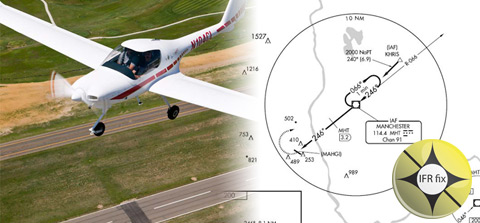
Nothing makes for a fun practice session like shooting the home-field instrument approach. The headings, frequencies, and minima all are as comfortable as the proverbial old shoe.
Too comfortable to be truly useful—and certainly not registering very high on the variety meter—but there’s no way you’ll gripe about that during today’s instrument proficiency check. You’re going to work hard and demonstrate this instrument approach for what it is—a sophisticated protocol for delivering pilot, passengers, and machinery safely to earth … or something like that.
Hmm. This is different. From where we have been navigating along Victor 106, we will have to proceed to the initial approach fix (IAF) on an unfamiliar heading. This is one of those approaches that employs a racetrack holding pattern as a procedure turn. Visualizing those entries has never been your favorite exercise. Which one should you use from here? Probably not the teardrop entry that works so well when you take off on Nashua’s RWY 14 and fly direct to the VOR.
Ready to copy? You are cleared present position direct KHRIS, then cleared for the VOR-A approach.
KHRIS?
A little-noticed detail of the published procedure now reveals its function. From your northeasterly position on the airway, KHRIS intersection serves as an IAF.
Reviewing the course (240 degrees) and altitude (2,000 feet) from KHRIS to the VOR, you learn the answer to that other nagging question about how to fly the procedure turn. “ NoPT.”
Well, that’s good news. Interesting, isn’t it, how that same old instrument approach can seem so foreign! This is almost like flying to a different airport (but cheaper).
Now your instructor—who’s part mind-reader and must have sensed your no-sweat attitude when the flight began—informs you that your DME has failed. OK, that raises the circling minima. It also means you must remember to time the 8.1-nm final approach segment, based on groundspeed.
“Bad news, Nashua’s altimeter setting isn’t available,” says your CFII.
She wouldn’t say that without a reason. So you check the approach plate, and notice an asterisk in the profile view and a note: “940 when using Manchester altimeter setting.” Does this note apply to you?
Too many questions. Distracting! Fly the airplane.
Field’s in sight. “Enter right base to RWY 32, cleared to land.”
Quite a workout, without ever getting more than 25 miles from home.
And that variety meter? It’s pegged.
Earning an instrument rating is guaranteed to be one of the most challenging, rewarding, and fun projects a pilot takes on during a lifetime in aviation. Each week, this series looks at the IFR experience from a new perspective. Catch up on what you may have missed in the IFR Fix archive. Have a suggestion for a future tip? Let us know.



